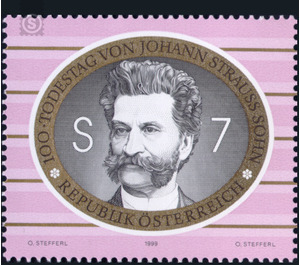100th anniversary of death - Austria / II. Republic of Austria 1999 - 7 Shilling
Theme: Art & Culture
| Country | Austria / II. Republic of Austria |
| Issue Date | 1999 |
| Face Value | 7.00 |
| Printing Type | combination printing |
| Stamp Type | Commemorative |
| Item Type | Stamp |
| Chronological Issue Number | 1628 |
| Chronological Chapter | OOS-OE2 |
| SID | 794227 |
| In 59 Wishlists | |
Johann Strauss Sohn, born on October 25, 1825, was destined by his father for the job of a bank clerk to spare him the hardships of the musician profession. But the frequent absence of his father from home made the son, however, the musical education. Without the knowledge of the "Waltz King" he learned piano and violin supported by his mother. After the father had left the family, he could devote himself entirely to music studies. In 1844 he made a sensational debut with a chapel in Hietzing, in which he also performed his own works "Sinngedichte" and "Gunstwerber" and thus became famous all over Vienna, which certainly contributed to the audience-effective rivalry with the father. After the death of his father, the son united the two chapels and led the new ensemble to even higher performances. "On the beautiful blue Danube" - probably his most famous composition - "Court Ball Dances", "Viennese Sweets", "Artist Life", "G'schichten from the Vienna Woods", "Enjoy your life", the series of great waltzes from the years 1865 to 1870, with which Johann Strauss had finally found his own style. From the beginning of the seventies, a change in the work of the master took place: Under the impression of the works of Jacques Offenbach and Franz von Suppé, Johann Strauss turned to the operetta. In this genre he was soon successful ("The Bat", "The Gypsy Baron"). The honorary citizen of Vienna was built in 1921 in the Vienna City Park the now world famous monument.


